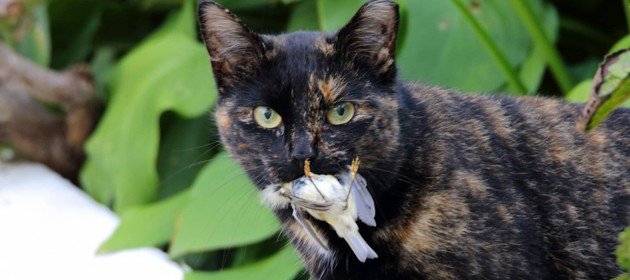
Mark Gamin, a Cleveland lawyer, likes cats and birds both. He likes books too, which made him the ideal reviewer for Cat Wars: The Devastating Consequences of a Cuddly Killer. This is Mark’s first contribution to 10,000 Birds.
 Agonizing quandaries concerning invasive species are well-known to wildlife biologists. In Oregon, the Barred Owl is taking over Northern Spotted Owl territory and threatening that smaller bird’s survival. Thus the decision was made to kill 3,600 Barreds, and it’s hard to fault the inescapable logic of doing so, as one Audubon Society director expressed it:
Agonizing quandaries concerning invasive species are well-known to wildlife biologists. In Oregon, the Barred Owl is taking over Northern Spotted Owl territory and threatening that smaller bird’s survival. Thus the decision was made to kill 3,600 Barreds, and it’s hard to fault the inescapable logic of doing so, as one Audubon Society director expressed it:
On the one hand, killing thousands of owls is completely unacceptable. On the other hand, the extinction of the Spotted Owl is completely unacceptable.
Other animal control issues that involve mass killing make for easier decisions, according to Peter P. Marra and Chris Santella, authors of Cat Wars: The Devastating Consequences of a Cuddly Killer (Princeton University Press, 212 pp., $24.95). They argue for the elimination of free-range cats entirely.
The relevant numbers involving cats, the people that cherish them, and the birds (and small mammals and reptiles) that they kill are all too large to mean much; you might as well use the funny word “gazillions.” Still, with the help of various sources, the authors have a try:
- Ninety million cats live in 46 million American homes;
- There are 100 million feral cats that live outside and eat mostly wildlife, and 50 million owned cats (i.e., pets) that roam out-of-doors;
- At least 500 milllion birds are killed by cats each year (but the number is probably higher, maybe twice that or more);
- Cat feces, via which a dangerous parasite is distributed, amount to 1.2 million metric tons per year in the United States alone; and
- (By the way, and for point of reference) there are some 47 million active American birders.
The book contains smaller numbers, too, but they can be as disturbing as some of the bigger ones, such as this: Thirty-three of 238 global reptile, bird, and mammal extinctions have been caused by domestic cats (versus zero confirmed bird extinctions, the authors say, from the pesticide DDT).
As Marra and Santella note, tens of millions of people have “a deep bond and connection with cats” precisely because they’re a little bit wild, among a multitude of other reasons including soft fur, cuddliness, and playfulness. Arriving in North America around the time of Columbus, they have become “one of the most successful invasive species on earth.”
It’s not just the effect of cats on wildlife that should be alarming, “Cat Wars” says. It’s also their role as “vectors of disease,” especially toxoplasma gondii. That parasite has the bizarre, powerful ability to manipulate the brain, and reshape the behavior, of its secondary hosts. Infected rats, for example, no longer shun cat urine but find it an aphrodiasic. There is evidence that toxoplasma leads, in humans, to an elevated risk of mental illness and depression.
The traditional, supposedly humane answer to the glut of feral cats has been institution of “TNR” programs – trap, neuter, return. Marra and Santella are very much anti-TNR, a view that is shared by others, including People for the Ethical Treatment of Animals (PETA), not to mention Birdchick. “TNR has repeatedly been shown to fail to reduce free-ranging cat populations,” the authors say (perhaps because the rate of sterilization in a discrete population has never been close to one hundred percent); and, in any event, neutered or not, feral cat lives are nasty, brutish and short.
The solution (the authors don’t dance around the point too much, though they do prefer the euphemism “euthanize”) is to kill all the unowned feral, cats, and to convince all cat owners to keep their pets indoors. They well understand, and acknowledge, that these things seem, today, unrealistic to the point of impossibility. First, there is a large and rabid — well, enthusiastic — cat lobby, including many people who support colonies of feral cats with food and otherwise, such as the large nonprofit group, Alley Cat Allies. And keeping cats, natural hunters, indoors is, as a matter of biology and of common sense, not the healthiest state for them. “Catios,” screened outdoor porches with climbing apparatus, aren’t really the answer, though some, like Peter Paonessa, have, to their credit, tried.
No matter. Attitudes change over time, Marra and Santella say, and with proper education about these “unrelenting killers and cauldrons of disease” the public may come to view pet ownership as one Auburn University professor quoted in this book does: “as a privilege, not a right.”
One might wish that “Cat Wars” had addressed a specific question: of the millions of birds that fall victim to cats each year, how many are House Sparrows – another hugely successful invasive species — or other aliens? Even bird lovers – especially bird lovers – might view kitty with a little more equanimity, knowing that he or she was ridding the backyard bird-feeder of those avian interlopers. . . .
In any event, “Cat Wars” is valuable in that it calls to attention a huge problem (set of problems, really) of which many people have, hitherto, been unaware — or ignored.
Cat Wars: The Devastating Consequences of a Cuddly Killer. By Peter P. Marra and Chris Santella. Princeton University Press, 212 pp., $24.95. Header image of feral cat with a Golden-crowned Kinglet by Isaac Grant











Leave a Comment